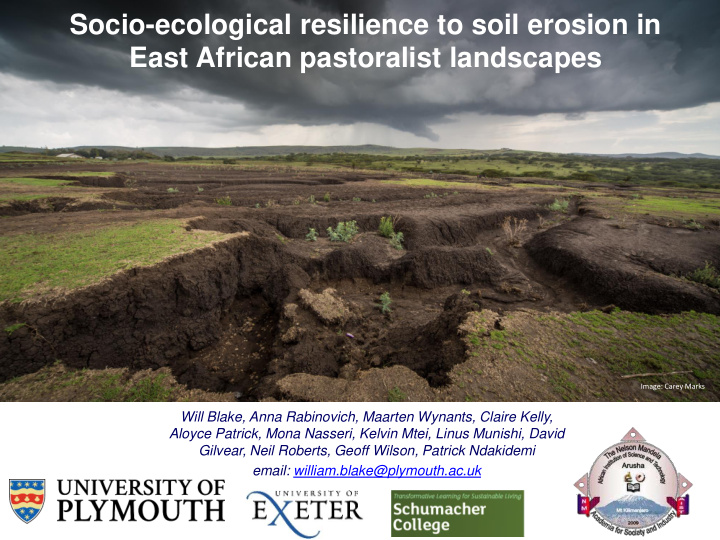



Socio-ecological resilience to soil erosion in East African pastoralist landscapes Image: Carey Marks Will Blake, Anna Rabinovich, Maarten Wynants, Claire Kelly, Aloyce Patrick, Mona Nasseri, Kelvin Mtei, Linus Munishi, David Gilvear, Neil Roberts, Geoff Wilson, Patrick Ndakidemi email: william.blake@plymouth.ac.uk
Funded by the Global Challenges Research Fund through NERC
Maasai pastoralist communities – northern Tanzania Image: Carey Marks
Across the landscape pastoralist communities are in transition
Extensive grazing land across the region … eroding at alarming rate Image: Carey Marks … socio -ecological system at a tipping point?
…soil resource is being washed away also threatening downstream ecosystems and livelihoods
The interdisciplinary Jali Ardhi project concept: supporting community adaption to soil erosion challenges ‘Socio -ecological resilience to soil erosion driven by extreme events: past, present and future challenges in East Africa’
Community resilience and soil erosion Human Natural soil factors factors erosion Wilson, 2013
Community response to ‘shocks’ is complex Wilson, 2013
Assessing soil vulnerability Sedimentary evidence of to erosion past and present baselines and rates of change Exploring socio- cultural drivers and challenges
Soil erodibility factors and processes drought -> grazing/clearance -> exposure -> low OM/RSSI -> crusting -> OLF - > incision…
OLF -> convergence -> incision -> connectivity ‘Soil erosion in Tanzania: In Pictures’ (Guardian online)
Applied environmental diagnostics tools: sedimentary evidence of landscape change
Comparing Local Environmental Knowledge, GE imagery and environmental diagnostics
Soil erosion causes, threats and impacts are becoming clear but adaption strategies are harder to develop and implement… Image: Carey Marks
Human-environment interactions amplified by climate change and socio-cultural feedbacks Image: Carey Marks
People are highly aware of the problem, and are concerned about impacts it has on them and future generations Cultural importance of cattle & cattle as Who takes Harmony in community is ‘savings account’ responsibility for more important than protecting environmental protection common land? But there are barriers to change… Lack of labour/tools Lack of skills and Perception of high for growing knowledge to switch to risk in growing crops alternative livelihood Image: Blake
Openness to change… but need a catalyst Education is valued Learning from others in community Learning from children Learning from negative experiences (2016 drought) Recognition that Cohesive Government and environment may NGO schemes communities force change Image: Blake
Stakeholder engagement
Exchanging knowledge & co-designing pathways to change through a shared community vision for the future
Next steps… “I’m glad that you have come to ask important things that are concerned about environmental degradation in this community. I’m very happy about your coming in this village because other researchers do come and after getting done with their activities they go and forget us without coming back. So are you also same as them or there is a way that you are going to help us in saving our environment from soil erosion problems?” Farmer, Emaerete Current NERC Follow-On research programme: “ Realising land management change in degraded Maasai grazing lands ”
Recommend
More recommend